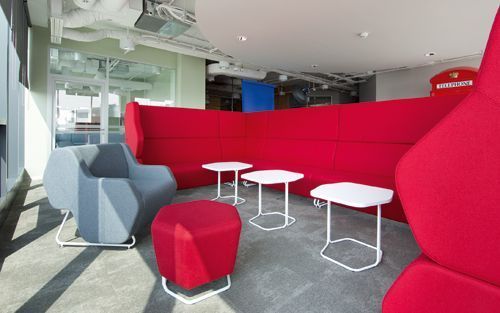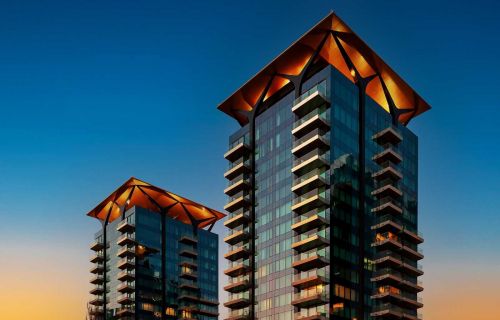People, process, place
Workplace solutions
There is no single concept for an ideal office, just like there is no single recipe for success in business. Every company is different, therefore it requires a unique, tailor-made office designed for the needs of the organisation and the people who work for it. When creating the arrangement for an office interior, it is worth taking into account all the three main aspects – the people, the processes and the place. The motivations for making changes to office space are varied, which makes it easier to define the most important aim and element of a particular project. The aspect of place – generally situations where the current location is too small for a company – can be the motivation for changing the office. Changes can also be initiated by the people working for the firm complaining about their offices, its appearance and functionality or the noise levels that lead to concentration and communication problems. Often it is the willingness to facilitate business processes that prompts the company to decide to rearrange its office space, so that it can reflect the network of connections and relations between departments. A well designed office increases the employees’ comfort and allows them to perform their tasks more efficiently, which results in the greater development of the whole company and its particular departments.
People’s expectations
Human capital is one of a company’s most valuable resources. In the current situation on the labour market, it is crucial to attract and keep the most talented people in the organisation. People’s awareness of what modern office space should look like is increasing. At the same time, their requirements towards employers in terms of the attractiveness of a workplace are growing. And this does not only boil down to its aesthetic qualities. An effective office allows people to work better, be more productive and minimises concentration problems. According to research, 87 pct of employees in the modern business services sector now expect flexible offices. Recently the style and character of office work have changed. Employees are dealing with more tasks that require interaction and cooperation in a team. So office space has to change in order to meet the current needs of its users.
It is also worth mentioning that up to 24 pct of employee job satisfaction is determined by the workplace. The level of employee job satisfaction has a huge influence on their motivation and encourages them to identify more with the company. This aspect is particularly important when it comes to generations Y and Z: millennials pay a great deal of attention to the image of the employer and take on board their friends’ opinions of it. The aspects connected with who they work for, whether the employer ensures proper conditions for carrying out their tasks and whether the organisation acts in a modern and flexible way, are key factors for them. Companies are recognising the importance of fostering the image of being an ideal employer and the office can be one of their main branding tools. Efficient and effectively arranged office space demonstrates that the firm takes care of its employees and provides them with comfortable working conditions and professional development possibilities. The office is now more often perceived in the context of motivation, since having the ideal working conditions and work style are regarded as the most effective motivating factors that influence an employee in both instant and more permanent ways.
Processes and relations between teams
Processes are particularly important to companies operating in the modern business services sector. When initiating an office arrangement project, it is worth analysing the key processes carried out by the company, the tasks the employees perform and the network of relations between the teams that cooperate with each other. It is necessary to answer questions about what the dominant work style is in each department in order to identify the right arrangement solutions. Another highly important aspect is to facilitate the communication between teams. In modern organisations the vast majority of tasks are performed in a team, therefore it is crucial to section off spaces for holding meetings, quick consultations and brainstorming sessions.
Every change in an organisation can engender anxiety and a fear of the unknown. The best solution for alleviating employees’ reluctance towards new office space is to help them go through the change process in a proper way. Multi-stage internal communication combined with employees’ active engagement in the process, e.g. by holding competitions for choosing the names of particular meeting rooms or the main theme of the chill-out zone, are examples of the change management concept that help people to identify with the changes and to develop the sense that they are co-creating their everyday work environment.
Place for efficient work
More and more companies are regarding their office as an investment and employing modern and more effective space arrangement patterns, e.g. the zonal office concept or the Activity Based Working trend. Workplaces arranged in this way are more employee-friendly, since they make use of the best elements of the open space concept, such as free information exchange, better communication and space optimisation. On the other hand, however, they offer something more – they provide employees with access to activity zones where they can perform particular types of tasks. The division of office space into communication, concentration and administration zones, as well as an entrance zone and a social zone, prevents employees from disturbing each other in performing their professional duties. Interestingly designed social zones, where employees can take a rest and spend their break with their colleagues, raise the morale of a team, while informal meetings over a cup of coffee are more effective than traditional ones held in conference rooms. Work performed with people who we know and like is more pleasant and more efficient at the same time.
The most important aspect of the whole space arrangement project is to create a unique combination of these three main elements. It is the company’s character and organisational culture that determine which aspect we will pay particular attention to. A well arranged office encourages employees to perform their professional tasks in diverse ways, both individually and in a team, while increasing their efficiency and acting as a catalyst for new ideas.





















































